April 13, 2018
Air Date: April 13, 2018
FULL SHOW
SEGMENTS
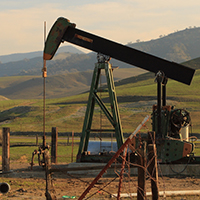
Making Big Oil Companies Pay for Climate Disruption
View the page for this story
A growing list of US cities and counties are suing fossil fuel companies for damages linked to human-amplified climate change. Among the biggest defendants are Shell and Exxon Mobil, and emerging evidence suggests that they understood the warming effects of greenhouse gas emissions decades ago. Host Steve Curwood spoke with UCLA law professor, Ann Carlson, about the cases and what redress the plaintiffs are seeking. (11:45)
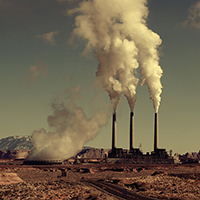
Pruitt's EPA Allows Dirtier Air
View the page for this story
In January 2018, the EPA revoked the Clean Air Act policy known as “Once In, Always In." This provision ensured that major sources of Hazardous Air Pollutants installed the most efficient control technologies and kept them running. This rollback by the Pruitt-led EPA allows these facilities to relax anti-pollution controls, as long as their emissions stay below “major source” limits. Earthjustice Vice President of Litigation, Patrice Simms, talks with host Steve Curwood about a lawsuit launched by environmental groups that seeks to put the tougher controls back in place. (08:50)
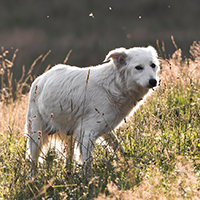
Leave No Poop Behind
View the page for this story
Research shows that most dog owners pick up after their pets in the street and at the local park, but often don’t take along a plastic bag when out hiking in the backcountry, assuming it’s no big deal. But Wes Siler, a contributing editor to Outside Magazine, tells host Steve Curwood that all that dog poop does add up to potential harm by introducing foreign bacteria and nutrients to forests, fields, and streams. (06:39)
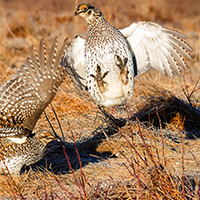
BirdNote®: Sharp-tailed Grouse On a Lek
/ Michael SteinView the page for this story
Male sharp-tailed grouse are among the few bird species that use communal mating dances to attract females. In today’s BirdNote®, Michael Stein describes the birds’ display and explains why the leks where they gather to dance are becoming more scarce. (01:50)
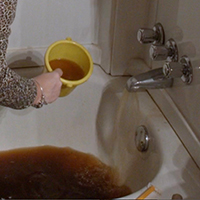
Spoiled Water for 300,000: What Lies Upstream
View the page for this story
A 2018 documentary film, What Lies Upstream, investigates a chemical spill in 2014 that left 300,000 West Virginia residents with unsafe drinking water. Filmmaker Cullen Hoback tells host Steve Curwood his work highlights how lax regulations for chemicals and shortcomings of government agencies exposed a sixth of the population of West Virginia to noxious drinking water, and how much of the rest of America is also at risk. (10:43)
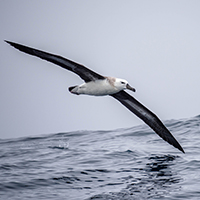
Beyond The Headlines
/ Peter DykstraView the page for this story
This week, tales of spies, murder, and divine intervention. Peter Dykstra and host Steve Curwood discuss researchers’ plan to use albatrosses fitted with GPS to find illegal fishermen, and a series of park ranger murders in Virunga National Park, DRC. From the murky depths of the history vaults, the duo look way back to a freak April storm during the Hundred Years War, that brought a truce. (03:44)

Bald Eagles At Play
/ Mark Seth LenderView the page for this story
Connecticut River ecosystems have been impoverished over centuries by logging and overfishing, but now American Bald Eagles are returning. Living on Earth’s Explorer-in-Residence Mark Seth Lender watches young eagles on the river as they lock talons and fly playfully and finds them compelling. (03:00)
Show Credits and Funders
Show Transcript
HOST: Steve Curwood
GUESTS: Ann Carlson, Patrice Simms, Wes Siler, Cullen Hobart
REPORTERS: Peter Dykstra, Michael Stein, Mark Seth Lender
[THEME]
CURWOOD: From Public Radio International, this is Living on Earth.
[THEME]
CURWOOD: I’m Steve Curwood. Fossil fuel companies are increasingly under legal attack for selling a product that damages the climate.
CARLSON: The science that connects what the defendants did to what the cities and counties are experiencing is much stronger than it used to be. Scientists can really connect now the emissions that the defendants put into the atmosphere to harms like sea level rise.
CURWOOD: Seeking compensation to protect coasts and harbors.
Also – our dogs are our best friends, but what they leave behind can imperil the ecosystem.
SILER: Just like human poop it's full of E. coli and fecal coliform and it's full of nitrogen and phosphorus which are the nutrients in fertilizer so its creating a nutrient imbalance in a wild ecosystem and that can lead to algae blooms in water and that kills fish.
CURWOOD: We’ll have that and more this week on Living on Earth – Stick Around!
[NEWSBREAK MUSIC: Boards Of Canada “Zoetrope” from “In A Beautiful Place Out In The Country” (Warp Records 2000)]
[THEME]
Making Big Oil Companies Pay for Climate Disruption
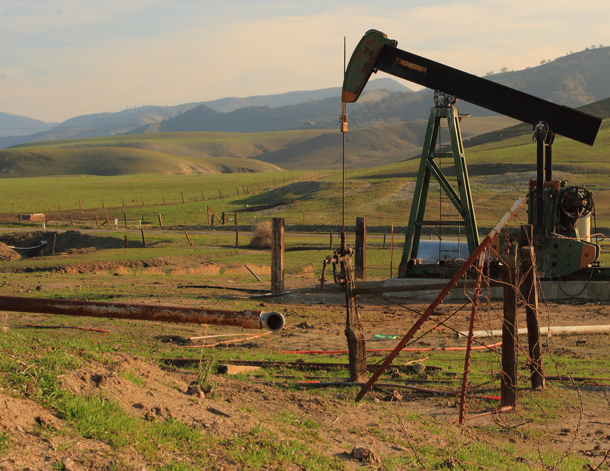
Oil wells are common across Southern California, and San Diego County’s Imperial Beach has joined San Mateo County and Marin County in Northern California to seek compensation from big oil companies for damages caused by sea level rise. (Photo: Kari Bluff, Flickr CC BY-ND 2.0)
CURWOOD: From PRI, and the Jennifer and Ted Stanley Studios at the University of Massachusetts, Boston, this is Living on Earth. I’m Steve Curwood. Major fights over the fallout of climate change are heating up in state and federal courts in California. The odds are long, but a win by the municipalities could prove historic. San Francisco, Oakland, Santa Cruz, and other towns and some counties have filed several actions against Chevron, Shell, Exxon Mobil and other fossil fuel companies, claiming the use of their products raises sea level.
The plaintiffs want these companies to pay for some of the infrastructure that is needed to protect against floods. Exxon Mobil and some other defendants allegedly knew for decades about the damaging impacts of carbon fuel on climate stability. To learn more, we called UCLA Law School professor, Ann Carlson. Welcome to Living on Earth Ann!
CARLSON: Thank you. Nice to be here.
CURWOOD: So, why now? Why are these cities and counties moving forward with these lawsuits?
CARLSON: Well, there's several reasons I think the cities and counties are moving forward with suing oil companies for the damages they are beginning to incur from climate change.
First, I think the science that connects what the defendants did to what the cities and counties are experiencing in sea level rise and other harms from climate change is much stronger than it used to be. Scientists can really connect now the emissions that the defendants put into the atmosphere to harms like sea level rise.
Second, there's really good information that the defendants knew about the harms of climate change long ago, as early as the mid-1960s, planned their own business operations around rising seas and other harms from climate change, and yet engaged in a campaign to try to mislead the public about whether climate change was actually occurring, and that's really important from a liability perspective.
CURWOOD: Why is that?
CARLSON: That's because in California where the vast majority of these lawsuits have been filed, the suits are brought under a doctrine known as public nuisance. And the California courts have made clear that when defendants in nuisance litigation are engaged in campaigns to try to mislead consumers about the harms of their products or to try to persuade the government not to regulate those harms, that makes a difference for determining whether the defendants are going to be held responsible for what they did.
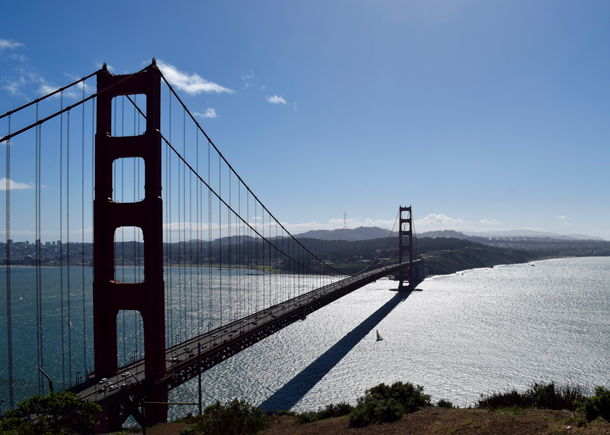
San Francisco is among the California cities suing big oil companies, including Exxon Mobil and Shell, for damages linked to climate change. (Photo: Savannah Christiansen)
CURWOOD: So, there are two lawsuits as I understand it. There's one in federal court and one in state court there in California and they are really saying pretty much the same thing. Why are they moving ahead in different arenas?
CARLSON: Well, there were a number of suits filed in a number of different California courts by different cities and counties in California, and the defendants in all of those lawsuits brought what's called a motion to remand to federal court. So, they would rather be in federal court than state court because California law is much more favorable to the plaintiffs in state court. There were two sets of lawyers and therefore two sets of remand motions to different judges. One judge decided that the cases should stay in federal court, and another judge decided that they should go back to state court, even though they're alleging pretty much the same thing.
CURWOOD: So, what are the likely arguments on each side of this case? I gather by now the oil companies aren't denying climate change exists, so what exactly is their defense?
CARLSON: The defendants’ principal argument against the plaintiffs is going to be that they pull the oil out of the ground, but they don't actually burn it. It's the burning of fossil fuels that creates the emissions that are warming the planet. Instead, they sell their products and then consumers combust the fuel when they drive cars or when they turn on the lights in the house, etcetera, and so I think they're going to try to argue that they're not the cause of the harm. They will have a bunch of other ways of trying to get the cases dismissed, but I think that's going to be their main argument.
CARLSON: So, how did that work for the tobacco companies that said that they only made the tobacco, it was the consumer that lit the cigarette?
CURWOOD: So, I think there are a lot of parallels between the tobacco litigation and the oil company litigation here. One is that the tobacco industry said they weren't causing harm, it was the consumers who were smoking the product causing the harm, and eventually, what the plaintiffs learned in those cases is that the tobacco companies were engaged in very extensive campaigns to try to get smokers to smoke, and not only that but to get them addicted to cigarettes through nicotine.
Similarly, here the oil companies clearly engage in big campaigns to get people to use their products and to persuade them that there's no harm. They engaged in a big campaign -- you may remember some of the advertisements that ran about how CO2 is actually good for the planet, about how there's scientific uncertainty about whether humans are causing climate change, all sorts of things funded by the oil industry. They even funded scientists to try to produce studies that cast doubt on whether climate change is occurring.
CURWOOD: All at the same time that they were planning their own construction and development based on things like rising sea levels.
CARLSON: That's correct. There's very good evidence that they were, for example, developing new technology so that they could begin to break through ice that was melting in the Arctic, that they were raising their oil platforms in anticipation of the fact that there was going to be sea level rise, knowing full well that the activities they were engaged in were going to be causing problems that then they were claiming weren't even occurring.
CURWOOD: So, let's say that the plaintiffs win some kind of a case here. What exactly would they win?
CARLSON: Well, they are seeking to have the defendants pay some of the costs of the damages that are already occurring from climate change and that will continue to occur in the future. So, one example is sea level rise. One of the things that's interesting about the science that we now have on sea level rise is that there is a pretty much linear correlation between increasing emissions and increasing sea level rise, and the defendants in a number of the cases, the plaintiffs have shown, contributed about 17.5 percent of that sea level rise through their emissions over the course of last 50 years. So, under these theories of how nuisance litigation works, a judge could say to the defendants, “You have to pay for 17.5 percent of the damages that cities are experiencing from the sea level rise that occurs around their city streets, that harms their city infrastructure and so forth”.
CURWOOD: Now, I note that the judge on the federal case, William Alsup, called for a five-hour climate science tutorial. Tell me what happened in that session and how unusual a move that was.
CARLSON: Well, Judge Alsup’s move was really unusual but he's done this in some other cases, not involving climate change but other subjects, where he uses his courtroom as an opportunity to learn about the problem that is involved in the litigation. And so he asked the plaintiffs and the defendants to come in and educate him about a number of important scientific components of climate change. What was really interesting about the hearing is that the defendant oil companies all admitted that humans caused climate change.
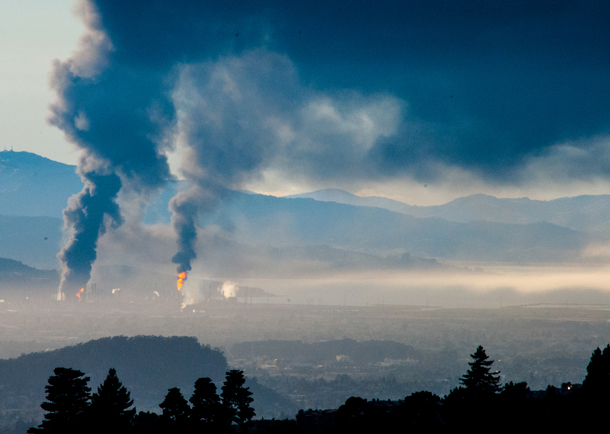
Chevron is among the list of defendants in the California cases. Above, the Chevron Richmond oil refinery in Richmond, CA, which caught fire in 2012, is located in the middle of the San Francisco Bay Area. (Photo: Stephen Schiller, Flickr CC BY-NC 2.0)
CURWOOD: Now, what effect do you think this will have on the on the case, that he did this tutorial?
CARLSON: Well, one thing that's interesting about the Judge Alsup case, that's the one in federal court, is that he made a very controversial decision to keep the case in federal court instead of sending it back to state court, and that's what the defendants wanted. But when he did that, he also made clear that he thinks that the case can probably go forward against the defendants. I think the defendants were trying to argue it should be in federal court, and the federal court should dismiss the case because the federal government's already regulating climate change emissions under the Clean Air Act and therefore we don't have a need for this kind of case. Judge Alsup in his ruling saying he was going to keep the case in federal court said, “No I think that this belongs in federal court and I think that's probably a claim that can go forward,” and then he held this hearing about climate science and another interesting thing that happened is that Chevron put on the scientific case and none of the other defendants said anything in court, and he wants all of them to also acknowledge that they believe that climate change is occurring.
CURWOOD: And in fact isn't this rather unusual that he is creating a record even before there is official discovery in this trial?
CARLSON: It's really interesting that he's holding this hearing. I don't know that it would be used as evidence once the case gets to trial, but it is a really important record to get the defendants right now saying up front, “We're not going to argue about whether climate change is occurring. We agree that it's occurring and we agree that we are that humans are helping to cause it”. Now, we're going to move on to the next question, which is what is the defendant's responsibility for the harm, not whether the harm is actually occurring.

Ann Carlson is the Shirley Shapiro Professor of Environmental Law at UCLA. (Photo: courtesy of UCLA)
CURWOOD: So, professor, I gather that Judge Alsup also asked for information about the experts that the oil companies put forward, in particularly, asked them to reveal their funding sources. Why did he do that and what did it reveal?
CARLSON: Well, I think Judge Alsup was interested in knowing whether the scientists that were testifying in front of him were credible. So, he wanted to know are there any reasons that they might be giving evidence to me that is skewed because, for example, they're getting money from the oil companies, they're getting money from the defendants. The result was that he found out that some of those experts had received funding in the past, but all of them were testifying at present in front of him without getting compensation from the oil companies.
CURWOOD: But some had done fairly well by the companies in the past it sounds like.
CARLSON: Yes, some of the witnesses had received funding from the oil companies in the past.
CURWOOD: Now, how is the emerging knowledge that companies including Exxon Mobil knew about human-caused climate change for years, how important is that in terms of moving these cases forward.
CARLSON: I think the evidence that Exxon and the oil industry more generally knew about climate change, changed their business plans as a result and then engaged in a campaign to dissuade the American public that climate change was happening and to try to persuade regulators not to regulate greenhouse gas emissions is key to the cases. I think it's really, really important. There's no way you can look at some of the internal documents that have already been uncovered from Exxon and the American Petroleum Institute and not think that their behavior was really, really problematic, and I think that's really going to matter in these cases.
CURWOOD: What do you suppose would have happened if instead of Exxon Mobil back in 1960 something or another had started to take action in favor of dealing with - with human-caused climate change? What kind of shape do you think we'd be in today?
CARLSON: If the oil companies had taken responsibility for the harms their products caused starting 50 years ago, we would see significantly fewer emissions in the atmosphere. I think we'd see a shift in how we use fossil fuels, maybe we'd figure out how to sequester the emissions that come from combusting fossil fuels or see a move toward cleaner fuels. If all that happened we would have far fewer emissions in the atmosphere and really importantly it would be cheaper and easier to get on a trajectory of emissions reductions that is going to be necessary to keep us at safe levels over the course of the next, you know, three to ten decades.
CURWOOD: Ann Carlson is the Shapiro Professor of Environmental Law at UCLA. Ann, thanks so much for taking the time with us today.
CARLSON: You're welcome, Steve. Good to be with you.
CURWOOD: When the suits were filed in 2017 Chevron spokeswoman Melissa Richie told the press: “Chevron welcomes serious attempts to address the issue of climate change, but these suits do not do that. Reducing greenhouse gas emissions is a global issue that requires global engagement and action.”
Related links:
- Inside Climate News: “Climate Legal Paradox: Judges Issue Dueling Rulings for Cities Suing Fossil Fuel Companies”
- Ann Carlson in San Francisco Chronicle: “Should oil companies pay for climate change? Yes, there is evidence”
- Chevron Statement About Climate Change
[MUSIC: Christoph Sietzen, “For Anna Maria” on Attraction-Works by Sejourne, Xenakis, Part, composed by Arvo Part, Genuin Classics]
CURWOOD: Coming up, the EPA takes heat on a move to roll back clean air protection. That’s just ahead on Living on Earth, keep listening!
ANNOUNCER: Support for Living on Earth comes from the Gordon and Betty Moore Foundation, and from a friend of Sailors for the Sea, working with boaters to restore ocean health.
[CUTAWAY MUSIC: Mark Birmingham, “Under the Moonlight” on Garden Life, rosemeadrecordings.com]
Pruitt's EPA Allows Dirtier Air
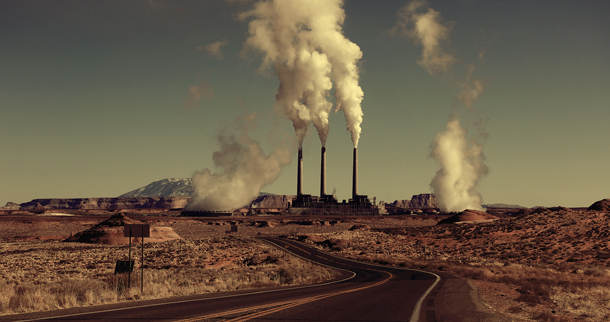
The air pollutants allowed to increase following the revocation of the “Once In, Always In” policy include toxins such as lead, mercury, and cadmium. (Photo: Eflon, Flickr CC BY 2.0)
CURWOOD: It’s Living on Earth, I’m Steve Curwood. In January, the EPA announced it was withdrawing the 23-year-old pollution control policy known as “Once In, Always In.” The Clean Air Act requires facilities that emit so much hazardous air pollutants that they are deemed to be major sources to restrict their emissions using the most effective technologies. And even when equipment causes emissions fall below the level to be rated a major source, those plants were still required to keep using the strongest and best methods. Under Scott Pruitt, the EPA has rolled back this rule and now allows these facilities to relax controls as long as they stay below the major emitter threshold. Seven environmental groups and the State of California say the rollback opens the door to huge increases in the release of dangerous air pollutants, and have sued the EPA, crying foul. Patrice Simms, Vice President of Litigation at Earthjustice, which is leading the green groups lawsuit joins us – welcome to Living on Earth!
SIMMS: Oh Steve, thank you very much for having me.
CURWOOD: Hey, give me a little bit of the history of the Once In, Always In, policy. When did it begin and what exactly did it provide in terms of protection from pollutants?
SIMMS: The Once In, Always In, policy is part of a regulatory program under the Clean Air Act, and that program deals with the control of hazardous air pollutants. Not the things that we often think about like smog, the stuff that you see hanging over a city, but rather these are highly toxic air pollutants, things that cause cancer and birth defects and neurological problems, lead and mercury and cadmium. So, the Once In, Always In, policy was a part of the suite of amendments to the Clean Air Act. These provisions said facilities have to get the greatest degree of reduction achievable, essentially saying everyone, if there's technology out there that controls these pollutants, everyone should have emissions that are consistent with the use of that technology.
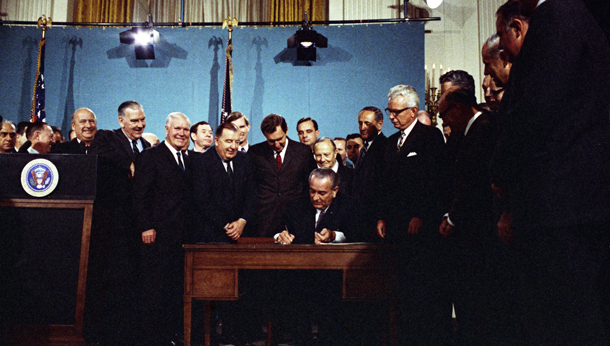
Enforcement of the Clean Air Act, which President Lyndon B. Johnson signed it into law in 1963, has included the “Once In, Always In” policy since 1995. (Photo: Wikimedia Commons, Public Domain)
CURWOOD: Well, that sounds reasonable. So, what is the problem now with this approach?
SIMMS: Entirely reasonable, right, and not just reasonable but super important because these pollutants as I said are pollutants that cause sort of catastrophic health effects. So, what's this Once In, Always In, policy? Well, one of the things that the statute did is it said that these standards apply to what are called major sources. The policy that has always been in place and been entirely reasonable is just because you've gone below the ten-ton threshold, which would identify you as a major source, doesn't mean that you stop being a major source. You continue to be a major source and have to continue using those control technologies.
CURWOOD: But now the Trump administration is saying, “Well, their emissions are really low now, so they're not major sources so they could actually raise their emissions”.
SIMMS: As long as those emissions don't go into major source territory again.
CURWOOD: Well, I can imagine the companies are saying, “Well, wait a second. We've done what we're supposed to do so we're not major emitters anymore”.
SIMMS: Well, and this is the whole point of Once In, Always In. The idea is once you are in, you are in, and you must continue to meet the criteria of the statute to get what is in the language of the statute, "the greatest degree of reductions achievable".
CURWOOD: So, how successful has this policy been in cleaning up the air during its time in place?
SIMMS: It's been quite successful. I would say they've achieved quite dramatic reductions in hazardous air pollutants across many different industries.

EPA Administrator Scott Pruitt has received criticism from both Democratic and Republican lawmakers who question his ethics and the many rollbacks that have happened during his tenure. (Photo: Gage Skidmore, Flickr CC BY-SA 2.0)
CURWOOD Now, let me see if I have this right. Back in the day, industry said don't actually set a limit. Just require us to use the best available technology. But, now this is being turned right around to saying, well, now that we've reduced these emissions, we should be able to go back up to what's just under the level that requires being listed as a major source.
SIMMS: Yeah, it's a baffling sort of logic here that if the program is successful, if the control technology really works, then you don't have to use it.
CURWOOD: So, I'm guessing the motivation for industry asking the Trump administration to make this change is money.
SIMMS: Absolutely. I think we have seen that this request has been made to EPA over a period of many, many years, and it is primarily driven by a desire not to have to incur the costs associated with cleaning up their discharges.
CURWOOD: Now, as I understand it, one of the organizations that has joined in your suit here has done a study. Talk to me about what they found in their study.
SIMMS: Just looking at a handful of facilities, EIP, Environmental Integrity Project, was able to determine what is the difference between, for some of these facilities, what they are achieving and what would be allowed if all they had to meet was the limit to remain a non-major source. And the - the results were pretty astounding. In many cases, what would be allowed is an increase of four or six or eight or ten times the pollution that's currently permissible, and in some instances, even much more than that.
CURWOOD: And if this were to proceed, what communities would be most affected?
SIMMS: So, it is the communities adjacent to and downwind of facilities that would be most directly affected, and not surprisingly, these communities are disproportionately low-income communities, disproportionately communities of color, and disproportionately communities that already are subject to exposures from a variety of different kinds of environmental burdens.
CURWOOD: What is the argument that the Environmental Protection Agency offers as to why they decided to revoke this Once In, Always In, policy?
SIMMS: The only rationale that the agency gives for this decision is a legal one, is a conclusion that the Once In, Always In policy is inconsistent with the statute.
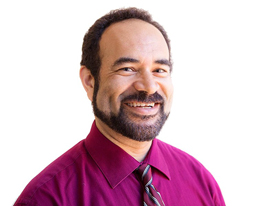
Patrice Simms is the Vice President of Litigation at Earthjustice, based out of Washington, D.C. (Photo: Earthjustice)
CURWOOD: So, is this already in effect?
SIMMS: The policy is in effect. From the agency's perspective, all they had to do was announce that this policy was being reversed and that was the end of the story.
CURWOOD: So, in cases, of course, of the Clean Air Act, you go straight to the Court of Appeals for the District of Columbia Circuit and what are you asking that court exactly to do?
SIMMS: We will be arguing to that court that the agency's action here was an impermissible and illegal one, and that the agency's decision should be held to be contrary to the statute and abandoned.
CURWOOD: So, in your view, what's illegal about this?
SIMMS: Well, it's flawed both procedurally -- there wasn't any kind of notice and comment process, nor any kind of technical or economic analysis underlying the decision -- and it's substantively flawed. It allows for an increase in emissions that is contrary to what the statute requires the agency to do and requires in terms of regulation of air pollutants.
CURWOOD: I understand there are no hard numbers out there, but how many Americans do you suspect are being put at risk of increased pollution?
SIMMS: There are many, many facilities regulated under this program. There are tens of thousands of individual facilities across the country that are subject to hazardous air pollutant controls under this regulatory program. And there are millions of Americans who are affected by the controls required by this program, that is millions of Americans who breathe cleaner air because of the controls that have been adopted under this program. So, that's what's at risk.
CURWOOD: Patrice Simms is the Vice President of Litigation at EarthJustice in Washington. Thank you so much for taking the time with us today.
SIMMS: Well, thank you so much for having me, it was a pleasure.
CURWOOD: Bill Wehrum, who leads the EPA Office of Air and Radiation, defended the rollback in a written statement. “It will reduce regulatory burden for industries and the states, while continuing to ensure stringent and effective controls on hazardous air pollutants,” he said.
Related links:
- Earthjustice’s press release on the lawsuit against the EPA
- Earthjustice’s Petition for Review
- The EPA’s announcement revoking the “Once In, Always In” policy
- The Environmental Integrity Project’s report examining the consequences of this rollback
[MUSIC: Christoph Sietzen, “Rebonds For Solo Percussion” on Attraction-Works by Sejourne, Xenakis, Part, composed by Iannis Xenakis, Genuin Classics]
Leave No Poop Behind
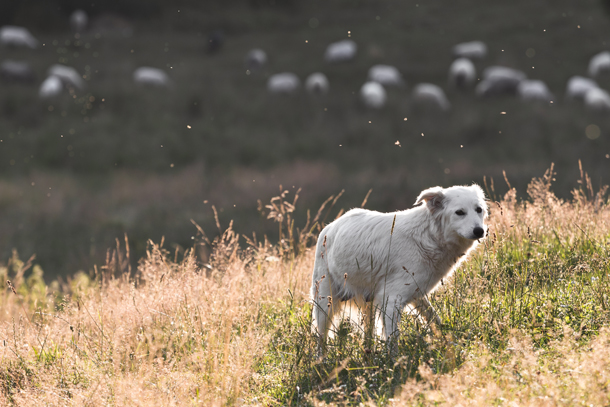
Dog poop affects natural environments by adding extra nutrients and foreign pathogens. (Photo: Jan Szwagrzyk on Unsplash)
[SOUNDS OF BARKING AND PLAYING DOGS]
CURWOOD: In the city, the dog park is a great place for our canine companions to burn off some energy playing with other dogs, and for us to get outside for some fresh air.
Now dogs are amazing, of course, having co-evolved with us humans to share our shelter and food supply and do everything from guarding us to giving us unconditional love.
Yet our dear dogs may pose a public health problem for nature and us.
Most people, of course, dutifully pick up after their pets. But sometimes people forget or the dog goes where it seems to be okay, such as out in the backcountry. And though it may not seem like a big deal, some experts say we should always take as much care with dog waste as we do with our own. Wes Siler is a contributing editor at Outside Magazine and recently wrote about all that poop that America’s nearly 90 million dogs generate.
SILER: We're talking about over 20 billion with a "B" pounds a year of dog poop, which is sort of the main issue here. It's a huge scale, which is a massive problem.
CURWOOD: So, you're talking about in the United States, not just around the world, it's the United States.
SILER: That's correct, 20 billion pounds a year in the United States alone.
CURWOOD: So, well you know, dog poop isn't exactly the most wonderful thing to look at and certainly nobody wants to step in it but, really, why is it a concern?
SILER: It's full of nasty stuff just like human poop. It's full of E. coli and fecal coliform and potentially parasites if it's an unhealthy dog and then also, if you think about the wilderness -- this was a new thing for me because I go camping with my dogs all the time -- I never thought about this, but dog poop is transporting foreign nutrients in sort of a massive scale into the wilderness. And it's full of nitrogen and phosphorus which are the nutrients in fertilizer. So, it's creating a nutrient imbalance in a foreign ecosystem or in a wild ecosystem, and that can lead to the ability for invasive species to grow or create algae blooms in water and that kills fish.
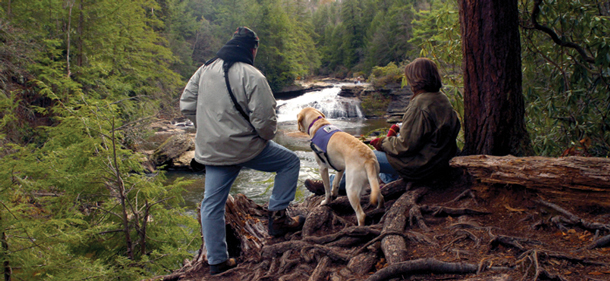
When hiking in the great outdoors with a dog it’s important to either bury a pet’s waste six inches deep, at least 200 feet away from a water source – just like you should for your own – or pack it out. (Photo: Maryland Department of Natural Resources)
CURWOOD: So, what's the research that actually quantifies how dog poop is potentially affecting streams or water sources?
SILER: You know, dogs are one of those things that aren't typically scientifically studied that heavily, so we're looking at two major studies here and that's it, we sort of have to extrapolate from there. So Leave No Trace, which is a wilderness education organization, did a study in Boulder, Colorado, where they found that in parks and on public lands in the city, something like 27 percent of dog owners aren't picking up their poop. And then there was a separate study done in Northern Virginia, they did DNA analysis of bacteria found in a stream and they found that dog poop was responsible for 42 percent of foreign harmful bacteria in that stream.
CURWOOD: Hmmm. So, alright, we should definitely then bring along those little plastic bag to pick up after our pet, whether in the great woods or at the great neighborhood park, but then, you know, the poop go into a landfill forever wrapped in plastic doesn't seem like a great option either.
SILER: Landfills get a lot of bad press, but they're actually a pretty proven system for eliminating the ability of waste to enter our ecosystem, so they're either lined with concrete or plastic or what have you that prevents stuff from trickling down in the ground water, They're capped, from preventing it from evaporating or otherwise entering the atmosphere. They're not perfect, certainly, but they're what we have and they do work to prevent the harmful stuff in trash and dog poop from entering the ecosystem.
CURWOOD: So, all right, so I’m out hiking in the middle of nowhere. I live in southern New Hampshire. In northern New Hampshire, we have these wonderful mountains, but Wes, I got to tell you I take my dog halfway up something like, say, Mt. Chocorua, and I don't really want to haul that plastic bag all the way back down the mountain with me filled with you know what. Those things get squishy in packs. What am I supposed to do?
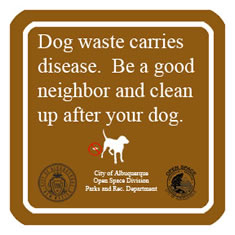
In many parks, signs remind dog owners to clean up after their dogs. (Image: City of Albuquerque Parks and Recreation)
SILER: Believe me, I get it. I don't want to haul poop either. Some environments, you do have to haul poop. If you're climbing up a pristine mountain, the Himalayas or the Cascades or something, you do have to haul it. But a lot of the time what you do with dog poop is the same thing you do with your own poop. You dig a six to eight inch deep cat hole and you bury it in the top layer of the soil, and in the top layer of the soil there's bacteria that are designed to break down poop and the poop disappears. So, literally, you just it treat the same way you would when you're camping. You dig that little hole, you kick the poop in it, job done. It takes two seconds.
CURWOOD: Now, how many dogs do you have, Wes?
SILER: I have two big dogs. I've got Wiley who's sort of an Akita mutt, 85 pounds, and I have Buoy, who's half Husky and half German Shepherd, just turned one and he's about 75 pounds.
CURWOOD: And just how many pounds of poop do they turn out a year?
SILER: [LAUGHS] Both of them produce together probably two pounds a day on an average day, and so you scale that to 365 days a year and you got a whole bunch of poop on your hands.
CURWOOD: Whoa, I hope it's not on your hands!
SILER: [LAUGHS] I hope not too. Everything’s gone wrong if it's on my hands.
CURWOOD: So, you have a couple of dogs yourself. When were you surprised by the scale of this problem?
SILER: You know, I just never really thought about it critically. Picking up dog poop as a normal dog owner to me it was just a matter of cleanliness. I don't want my yard to be full of dog poop. I don't want to leave behind poop on a hiking trail, but when I was camping I never really thought about the need to bury it. My dogs go poop in a bush and I left it always, but researching this article and the stuff that I learned has really taught me that we do need to be picking up the poop. And when you think about, you know, OK, I'm camping somewhere pristine, I’m going up to the mountains...what's one or two dog poops going to do to the environment? But you think about a pristine environment, altering it in any way does alter it and you scale that across you know, 100 campers a year, 1,000 campers a year, 5,000 campers a year in that location, and all of a sudden it does become a real problem.
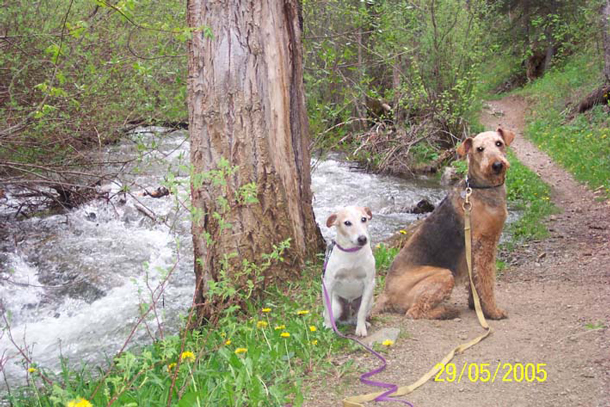
A study in Virginia found that 42% of controllable bacteria in a local river came from dog waste. (Photo: U.S. Forest Service)
CURWOOD: What prompted you to look into this?
SILER: [LAUGHS] I had written an article about the problems with mountaineers throwing their waste into glacier crevasses and that eventually being preserved and flowing out into streams in Alaska, and somebody from Leave No Trace, which is a really cool organization read that and emailed me and said, “Hey, let's talk about dog poop,” and here we go. So, I guess I'm a poop expert now.
CURWOOD: Mmm. OK. Well, you know in this business getting a scoop is a good thing isn't it?
SILER: [LAUGHS] Hey, the article has proved popular, so I'm not complaining.
CURWOOD: Wes Siler is Contributing Editor at Outside Magazine. Wes, thanks so much.
SILER: Thanks for having me. This was great.
Related links:
- Outside Magazine: “It’s Time to Talk About Poop”
- Leave No Trace: “Wildlife Poop Versus Dog Poop: Explained”
[MUSIC: BIRDNOTE® THEME]
BirdNote®: Sharp-tailed Grouse On a Lek
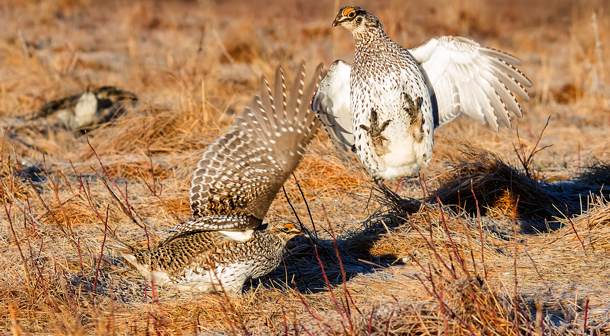
Two grouse tango. (Photo: Daniel Arndt)
CURWOOD: We stick with the great outdoors for today’s BirdNote – in particular the wide open prairie before the dawn’s early light. Here’s Michael Stein.
BirdNote®
Sharp-tailed Grouse on a Lek
[Display sounds of male Sharp-tailed Grouse]
It’s before dawn, this April morning, on a North Dakota prairie. Sitting quietly near a rise of ground, we begin to hear eerie whoops and cackling. [display sounds of Sharp-tailed Grouse] And then what sound like little motors running. [“motor” sounds made by the rattling of tail feathers while stomping very rapidly]
At first light, we see the source of this otherworldly chorus: male Sharp-tailed Grouse performing their elaborate mating dances. The size of small chickens, they dance on a matted patch of ground called a lek. Together, they’re stomping their feet, extending their wings, and zipping around the lek. Then, at the same instant, they stop – stock-still. All this to impress the female grouse observing from the sidelines.
[Mating display sounds of Sharp-tailed Grouse]
This wondrous, strange display is rare. Throughout the world, very few species of birds, perhaps fewer than 100, use leks when breeding.
With oil and gas drilling and the conversion of grasslands to agriculture, habitat for Sharp-tailed Grouse is becoming scarcer and more fragmented.
[brief cooing]

Sharp-tailed grouse. (Photo: Daniel Arndt)
This morning, the Lostwood National Wildlife Refuge in North Dakota gives our birds a place to reenact their ancient ritual and begin the cycle of their lives anew.
I’m Michael Stein.
[Mating display sounds of Sharp-tailed Grouse]
###
Written by Todd Peterson
From a Conversation with Gerrit Vyn
Bird sounds provided by The Macaulay Library of Natural Sounds at the Cornell Lab of Ornithology, Ithaca, New York. Mating display sounds of male Sharp-tailed Grouse [141142] recorded by Gerrit Vyn.
BirdNote’s theme music was composed and played by Nancy Rumbel and John Kessler.
Producer: John Kessler
Executive Producer: Chris Peterson
© 2005-2018 Tune In to Nature.org April 2018 Narrator: Michael Stein
Lostwood National Wildlife Refuge, http://www.fws.gov/lostwood/lostwoodnwr.htm
https://www.birdnote.org/show/sharp-tailed-grouse-lek
CURWOOD: For some photos -- stomp on over to our website, loe dot org.
Related links:
- Listen on the BirdNote® Website
- More on the Sharp-tailed Grouse
[MUSIC: Daniel & Amy Carwile, “Amazing Grace” on Col Arco, attributed to John Newton/public domain, www.DanielandAmyCarwile.com]
CURWOOD: Coming up, what happened in West Virginia when the water started tasting like licorice. That’s just ahead here on Living on Earth, stay tuned.
ANNOUNCER: Funding for Living on Earth comes from you our listeners, and United Technologies - combining passion for science with engineering to create solutions designed for sustainability in the aerospace, food refrigeration, and building industries. UTC companies such as Otis, Carrier, Pratt & Whitney and UTC Aerospace Systems are helping to move the world forward. This is PRI, Public Radio International.
[CUTAWAY MUSIC: The Glenn Miller Orchestra, “Begin the Beguine” on Big Band Sounds, composed by Cole Porter, Direct Source Records]
Spoiled Water for 300,000: What Lies Upstream
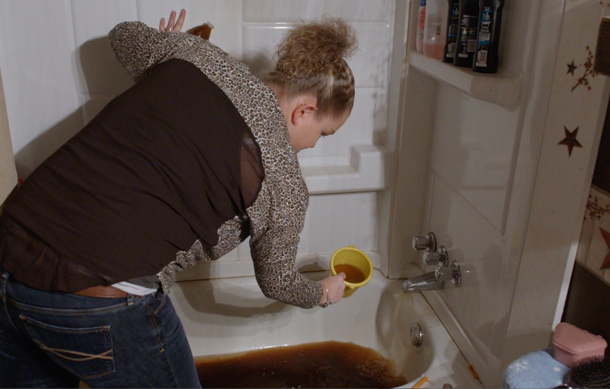
A West Virginia resident shows the brown water that flows from her tap. (Photo: Hyrax Films)
CURWOOD: It’s Living on Earth, I’m Steve Curwood. Perhaps the most famous concentration of chemical plants, “Cancer Alley,” lies along the Mississippi between Baton Rouge and New Orleans with more than a hundred petro-chemical refineries and factories. But the rivers near Charleston, West Virginia have a region with a similar name, Chemical Alley, with hundreds of coal mines and dozens of chemical plants.
WEST VIRGINIA RESIDENTS: We used to never have a problem then they put mines up here, mines up here and stuff and then all that sludge and slurry, even into the aquifer it's dripping. And then for years they said it smells funny but it's OK to drink it. Half the people in this trailer park died from cancer.
CURWOOD: Those voices come from a new documentary, What Lies Upstream, that tells the tale of an industrial chemical leak that left 300,000 people with unsafe drinking water. Documentary film producer Cullen Hoback went to Charleston shortly after the water went bad – for a week, he thought. Instead he wound up living there for a year and tells a complicated tale of weak regulation and lax enforcement, and the chemical that fouled the water for a sixth of the people living in West Virginia.
HOBACK: The chemical is called MCHM and it spilled into the Elk River, and for some reason, the Elk River was the only viable source of clean drinking water in the entire region. What made MCHM unique is that MCHM had a very particular quality. You could smell it in the parts per billion, and what that means is that with the tiniest, tiniest fraction of a drop, if you were to put it in a pool, you would still be able to smell it, and that smell was licorice. So, had there been no smell the contamination wouldn't have been uncovered, and people would have just drank the water without knowing.
CURWOOD: Tell me what MCHM is used for.
HOBACK: It's called a coal flocculant, and it's used to help separate the coal. It's part of the coal process. And MCHM was labeled as a non-hazardous chemical, which is important because there are less regulations on it. There's no required inspections of tanks that hold non-hazardous chemicals, there's less rules and controls over how the information around that chemical needs to be reported.
CURWOOD: Wait a second, you're saying it's labeled as a non-hazardous chemical, it’s safe to drink?
HOBACK: This was the question right -- is it non-hazardous? What levels are acceptable? In fact, there are only 72 chemicals that water companies are actually required to test for. So, if these other chemicals get into a water supply, like MCHM, it's legally allowed to be there. Companies aren't required to test for it, and there are over 100,000 chemicals used in commerce that are also labeled non-hazardous which are also able to be in drinking water. This chemical, because it had an odor, people started looking into it, looking into the data behind it and uncovering that, gosh, this chemical is actually a lot more harmful than we thought it was. In fact, it was twice as toxic as the chemical company who made this chemical, Eastman Chemical, had originally reported.
CURWOOD: So, what are the potential health effects or people who were exposed to MCHM?
HOBACK: Yeah, in the very beginning the CDC had reported that you could drink it at one part per million. Anything lower than that would be safe to drink. They later reversed that decision and said, “Well, actually maybe it's not OK for pregnant women”. The reality was is that they were using a tiny amount of science that had been produced by the company. They had no idea really what the effects were, they just thought they did.
There were many people who were having significant reactions to it that weren't in line with the data that had been reported. So, this means that people were having rashes. I talked to one family who there was a little girl whose neck inflated to the size of like a balloon from exposure to this chemical, and people were scared. They had no idea what was causing this originally, and at the same time, the government was coming out and saying, “No, the data says that this chemical couldn't have this effect, certainly not at these levels. You're wrong, you're making this up”.
CURWOOD: Now, at one point you have a scene in your film where you're actually present at a meeting between some industry lobbyists and the head of the West Virginia Department of Environmental Protection. Let's hear a bit of that.
MAN1: Where do you guys see the issue we already have covered?
MAN2: The more hazardous or dangerous it is, then it needs to be included in level one.
MAN3: We don't think that's workable for us.
MAN1: We're already covered under adequate, stringent regulations.
MAN2: That's not going to work. I'm telling you. We'll go back to Bramwell for exemptions to coal mining operations.
MAN3: I think we've done all the damage we can do today.
CURWOOD: I guess the take home here is that industry lobbyists are really helping to actually write the legislation that regulates them.
HOBACK: Yes, so this is a strange turn for me. You know, you hear all the time that this is what happens behind close doors, but you never see it. They were literally writing the law. So, they were crossing things off, they were saying what they would and wouldn't accept, and their word was as good as the law. Nobody had any, any power against them.
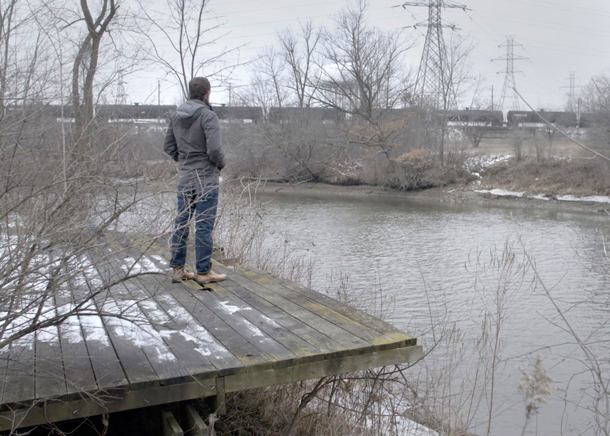
At the Flint River during the 2016 crisis, What Lies Upstream director Cullen Hoback looks at the iconic water tower in the distance. (Photo: Hyrax Films)
CURWOOD: Now, you spoke with Mark Edwards, he's at Virginia Tech who helped expose problems with lead in a number of communities, Flint and Washington D.C. Let's listen to a bit of that.
EDWARDS: I have fought a 12-year battle in Washington D.C. exposing government science agency corruption. The Center for Disease Control, the US EPA, the environmental policemen we pay to protect us were actually the environmental criminals. I had to betray some of my best friends, people I went to graduate school with who were working with the EPA and creating fabricated reports.
CURWOOD: Now, why do you think that the agencies tasked with ensuring public health are not taking seriously this issue of safe drinking water?
HOBACK: That is a great question and that is the exact question I asked Dr. Mark Edwards. I repeatedly asked him, “Why, why, why, why would scientists create fake data in ways that harm public health? Why would the CDC and E.P.A. cover things up like this?” It didn't make any sense to me. I thought they were the good guys. He had to very politely and kindly answer my question over and over again. One thing he says is, “Well, why would the Catholic Church do what it did?”
If you incentivize people to do the wrong thing and they can get away with it, they will do that, and what we see in both of these agencies is the incentivization of bad behavior. Don't find bad things. Scientists who try to do the right thing, they get fired, so what happens over time is they just stay in this agency of sort of non-enforcement that is trying to protect its funding, is trying to look good in the eye of the public, and then you have officials who run these agencies that are appointed by politicians who are beholden to corporate interests, to the lobbyists, and so what happens is there is a culture that, like a trickle-down effect from these top officials, and that's what creates this culture of non enforcement.
CURWOOD: We have in our modern industrial society released enormous amounts, quantities and varieties of chemicals into the environment. If one were to spend the day doing an assay for each one of these it would take 100,000 days to figure out what's out there. So, to what extent are regulators caught in this web of really our unrestrained use of chemicals?
HOBACK: You're right. There is this problem of just chemicals are innocent until they're proven guilty, they get released on the market, it takes far longer for a regulatory agency to investigate the chemical and prove that it causes harm than it does for the company to release it, use the chemical commercially, and by the time the EPA figures out, “Gosh, this actually is harmful”, the company can just move on to a different chemical, they can just flip the structure or change it a little bit. The entire system for how chemicals are made, how they're used in commerce, is completely backwards.
CURWOOD: Cullen, you actually took some water samples from the river near some of the various chemical storage facilities and found relatively low levels of concerning chemicals, but you say they end up somewhere that, well, it's rather surprising. Tell me more about that.
HOBACK: So, similar to the situation with MCHM, we thought, well, maybe we're going to find a lot of other chemicals in the river. Well when we got back our results, we were shocked to find that there were no major quantities of anything in the river. So, I talked to Dr. David Lewis, I got in touch with him, an ex-EPA whistleblower who focuses on issues around sewage sludge. And he clued me in and he said, “Well, companies aren't just flushing chemicals down the drain into the river any more, they're flushing chemicals down the drain like you flush chemicals down the toilet”.
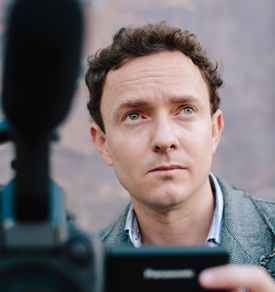
Filmmaker Cullen Hoback’s documentaries have been described as non-fiction horror. (Photo: Cullen Hoback)
So, instead of those chemicals going into the river, they were now going into the wastewater treatment plants that were processing them along with sewage sludge, human feces, everything else, and then that was being used to fertilize the lands of America, public lands, and being used all over the country, and so every chemical known to man was ending up in our soil, and then gosh, you know what happens when it rains? That goes right back into the river, and that's what we were finding.
CURWOOD: Please put this story in context for us in terms of drinking water safety in the US as a whole.
HOBACK: I think what you see in the film is what we imagine is a problem, it’s just something that would happen in the Chemical Valley, in fact, a problem that is happening nationally. If you could smell all of the chemicals that are in your drinking water right now like people in West Virginia could smell MCHM, it would be an insane bouquet of scents, you wouldn't be able to drink it.
CURWOOD: What should people do who are listening to us who are maybe concerned about the safety of their own drinking water?
HOBACK: If you use a Brita filter, it'll take out some heavy metals, it'll make your water more safe, but certainly not safe completely because we don't know enough about the chemicals that will still be appearing in that water. There are ways to make things marginally safer, but the reality is that we're going to all be exposed to these chemicals until we start to get the entire regulatory scheme around them under control.
CURWOOD: Cullen Hoback's new film is called "What Lies Upstream." Thanks so much for taking the time with us today.
HOBACK: Love your show. Thanks for having me.
Related links:
- What Lies Upstream first airs on PBS 4.1.6.18- check your local station for listings
- Cullen Hoback
- What Lies Upstream: producer's page
[MUSIC: Daniel & Amy Carwile, “Hot Java” on Col Arco, composed by Daniel Carwile, www.DanielandAmyCarwile.com]
Beyond The Headlines
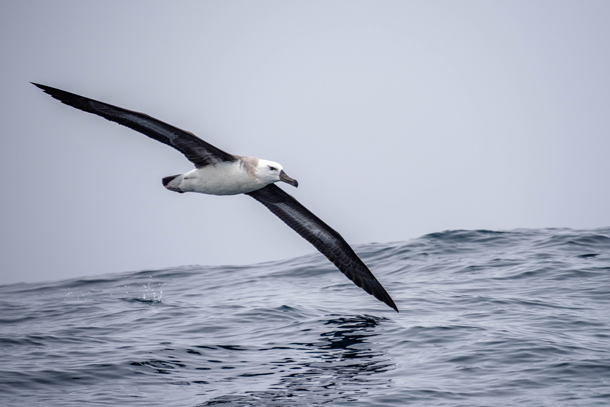
Researchers attached GPS trackers to albatross in order to spot illegal fishing because the bird is known to congregate around active fishing vessels. (Photo: Ade Russell, Flickr CC BY-NC-ND 2.0)
CURWOOD: Time now for a look Beyond the Headlines with Peter Dykstra. Peter’s an editor with Environmental Health News, that’s EHN.org and DailyClimate.org, on the line now from Atlanta, Georgia, and, Peter, I think you guys down south have stolen our spring! I had to scrape my windshield this morning.
DYKSTRA: Yeah, we’ve got plenty of spring down here with the azaleas and magnolias coming out. But we’ll all draw even in August when it’s a hundred degrees in Georgia, or maybe a hundred degrees in May.
CURWOOD: [Laughs] Okay, I can’t wait for that. What do you have for us today?
DYKSTRA: Well let’s go to the noble albatross, a huge seabird being used potentially as spies as part of a research project in the Crozet Islands in the far Southern Indian Ocean.
CURWOOD: How do you make an albatross into a spy?
DYKSTRA: Well there’s some illegal fishing going on, particularly in the southern ocean, and, uh, consider the albatross as a drone with a beak. Scientists are attaching GPS devices to the big birds; they tend to congregate around fishing boats, and it would be one way to track, potentially, illegal fishing boats in the Southern Ocean.
CURWOOD: Hmm. Reminds me of that poem, what is it?
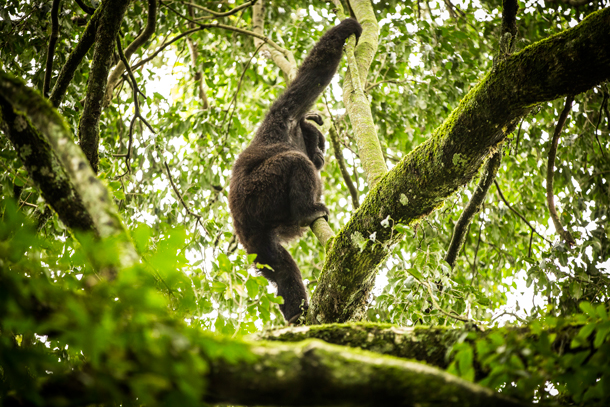
Virunga National Park is home to one of the largest wild mountain gorilla populations in the world. Hundreds of park rangers have been killed in their efforts to protect the park from exploitation. (Photo: Joseph King, Flickr CC BY-NC-ND 2.0)
DYKSTRA: The Rime of the Ancient Mariner, where a sailor killed an albatross and the rest of the crew felt so guilty about it they made him wear the albatross around his neck for the rest of the voyage.
CURWOOD: Huh, seems like the albatross might get hung around the neck of the illegal fishers, huh?
DYKSTRA: That’s right, except bear in mind that the albatross is a huge bird. It can weigh almost up to thirty pounds, and that would be a tough thing to wear around anybody’s neck.
CURWOOD: [Laughs] Indeed. Hey what else do you have?
DYKSTRA: Let’s go to Africa and Virunga National Park, founded in 1925, one of the oldest parks in Africa in the Democratic Republic of Congo. There are 400-plus mountain gorillas there, one of the strongest mountain gorilla populations left in the world. But over the last twenty years, over a hundred and eighty wildlife rangers have been murdered trying to protect mountain gorillas in the park, including six, five rangers and their driver, that were just murdered this past week.
CURWOOD: Why, why?
DYKSTRA: Well, there’s a market for charcoal in the park. It’s used by existing rebel armies. And they want to wipe out the game wardens in the park to get to the charcoal, not necessarily to get to the gorillas.

On April 14, 1360, a sudden lightning and hailstorm barraged King Edward III’s troops, killing 1000, as they advanced to Paris. The weather was seen as a sign from God to end the Hundred Years War between France and England, and a truce that lasted 9 years ensued. (Photo: Kim Stovring, Flickr CC BY 2.0)
CURWOOD: Oh my. So what do you have from the history vault for us this week?
DYKSTRA: I think this is going to be the farthest back in history we’ve ever gone. April 14th in the year 1360, in the midst of the Hundred Years War between England and France. The troops of King Edward III were advancing on Paris and there was a freak wind and hail and lightning storm that killed a thousand English soldiers.
CURWOOD: I imagine that kind of freaked people out as well, huh?
DYKSTRA: It freaked them out completely, and rather than thinking of this as a meteorological event, there was a tendency among both the French and English to think of it as a sign from God. So that resulted in a nine-year treaty, a nine-year pause in the Hundred Years War. Probably saved some lives, which was a good thing. Got to remember, during the reign of King Edward III something else was going on: that was the Black Death, the Bubonic Plague. It killed about a third of the people in England and on the European continent.
CURWOOD: Whoa. We have troubles now, but I don’t think they’re quite that bad.
DYKSTRA: No, not that bad, but our troubles now are something to worry about as well.
CURWOOD: Hm. Peter Dykstra’s with DailyClimate.org and Environmental Health News, that’s EHN.org. Thanks Peter, we’ll talk to you again real soon!
DYKSTRA: All right, Steve thanks. Talk to you soon.
CURWOOD: And there’s more on these stories at our website, LOE dot ORG.
Related links:
- Hakai Magazine: “Turning Birds into Spies Against Illegal Fishing”
- The Guardian: “'We know we may be killed': the rangers risking their lives for Virunga's gorillas”
- The Guardian: “Six Virunga park rangers killed in DRC wildlife sanctuary”
- Nick Kristof of The New York Times: “Choosing Animals Over People?”
- History.com: “This Day In History, April 13th, 1360: Hail kills English troops”
[MUSIC: Michala Petri/Danish National Vocal Ensemble/Stephen Layton, “I” (2011) on The Nightingale, composed by Sunleif Rasmussen, OUR Recordings]
Bald Eagles At Play

Two juvenile bald eagles fly close and lock talons. (Photo: Mark Seth Lender)
CURWOOD: The Bald Eagle is America’s symbol, a mighty, majestic bird that was nevertheless hunted and reviled by farmers who blamed it for killing livestock. Hunters, along with the pesticide DDT, proved all too successful, reducing the population in the Lower 48 states to barely 400 pairs by the 1950s.Their numbers have recovered since though, and now eagles can often be seen in comparatively suburban settings. But as Living on Earth’s Explorer-in-Residence Mark Seth Lender observed, wherever you see them they’re compelling.
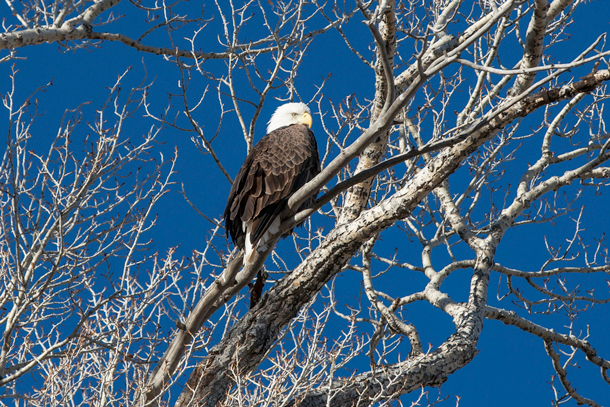
An adult bald eagle looks out from his perch with a steely gaze. (Photo: Mark Seth Lender)
LENDER: Under clouds like a lead yoke, sun rises over sea smoke, painting color on the sky. Up the river over ice floes, at the bloom of the dawn rose, bald eagles rub their eyes. In their cold perches on dead branches of the riverside hemlocks, in the red raw hour as day flowers they are hardly, alive.
Not a clawed foot reaches.
Not a wing stretches.
Not a sparrow, flies.
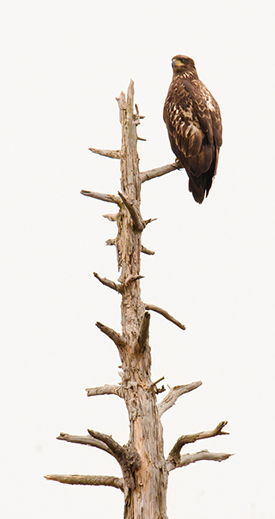
A juvenile bald eagle perched high in a dead tree. (Photo: Mark Seth Lender)
This was a rich place once. Salmon and shad and menhaden traveling that fateful underwater road built on the ebb and flow of the tide. Up where the coves creep down and the river narrows, from salt to sweet over falls and shallows mortal fishes spawned and died. While the Atlantic sturgeon sowed his seed, and watched the centuries unwind.
Giant oak and tall pine lined the galleries and held the banks. We felled them for our tall ships. We carved the islands like carcasses to ballast those ships in gray granite blocks like tomb stones. We reaped the fish with mile-wide nets (billowing shadows of the Shadow of Death) and when there was almost nothing left, the last of the scales and gills and bones we ground to dust to feed our corn rows planted in unfertile ground.
But the young eagles know none of this. Care for none of this. Two fathom wide of wing spread between them, young Princes of status and of privilege, they prance upon the sands of 8 Mile Bar. The mates that they will find await them. The nests they will build in the trees that remain will caress the eggs they will guard. The young they themselves will feed on the fish such as they can find...
Determined and speeding, against all odds and dangers, they will lock talons, and rise again gleaming, Kings of the Air! And have a future. Such as we might leave them: to live, upon the gleanings.
CURWOOD: Mark Seth Lender is Living on Earth’s Explorer-In-Residence.
Related links:
- Mark Seth Lender’s website
- Special thanks this week to Connecticut River Expeditions and the boat Riverquest
[MUSIC: Simone Dinnerstein, “Goldberg Variations, Canone alla Quarta: Variation 13” on Bach: Goldberg Variations, BWV 988, composed by Johann Sebastian Bach, Telarc]
CURWOOD: Living on Earth is produced by the World Media Foundation. Our crew includes Naomi Arenberg, Bobby Bascomb, Savannah Christiansen, Jenni Doering, Jaime Kaiser, Hannah Loss, Don Lyman, Helen Palmer, Aynsley O’Neill, Adelaide Chen, and Jolanda Omari.
Jake Rego engineered our show, with help from John Jessoe. Alison Lirish Dean composed our themes. You can hear us anytime at L-O-E dot org - and like us, please, on our Facebook page - PRI’s Living on Earth. And we tweet from @livingonearth. I’m Steve Curwood. Thanks for listening!
ANNOUNCER1: Funding for Living on Earth comes from you, our listeners, and from the University of Massachusetts, Boston, in association with its School for the Environment, developing the next generation of environmental leaders. And from the Grantham Foundation for the protection of the environment, supporting strategic communications and collaboration in solving the world’s most pressing environmental problems. Support also comes from the Energy Foundation, serving the public interest by helping to build a strong, clean, energy economy, from Carl and Judy Ferenbach of Boston, Massachusetts and from SolarCity, America’s solar power provider. SolarCity is dedicated to revolutionizing the way energy is delivered by giving customers a renewable alternative to fossil fuels. Information at 888-997-1703. That’s 888-997-1703.
ANNOUNCER 2: This is PRI, Public Radio International.
Living on Earth wants to hear from you!
Living on Earth
62 Calef Highway, Suite 212
Lee, NH 03861
Telephone: 617-287-4121
E-mail: comments@loe.org
Newsletter [Click here]
Donate to Living on Earth!
Living on Earth is an independent media program and relies entirely on contributions from listeners and institutions supporting public service. Please donate now to preserve an independent environmental voice.
NewsletterLiving on Earth offers a weekly delivery of the show's rundown to your mailbox. Sign up for our newsletter today!
 Sailors For The Sea: Be the change you want to sea.
Sailors For The Sea: Be the change you want to sea.
 The Grantham Foundation for the Protection of the Environment: Committed to protecting and improving the health of the global environment.
The Grantham Foundation for the Protection of the Environment: Committed to protecting and improving the health of the global environment.
 Contribute to Living on Earth and receive, as our gift to you, an archival print of one of Mark Seth Lender's extraordinary wildlife photographs. Follow the link to see Mark's current collection of photographs.
Contribute to Living on Earth and receive, as our gift to you, an archival print of one of Mark Seth Lender's extraordinary wildlife photographs. Follow the link to see Mark's current collection of photographs.
 Buy a signed copy of Mark Seth Lender's book Smeagull the Seagull & support Living on Earth
Buy a signed copy of Mark Seth Lender's book Smeagull the Seagull & support Living on Earth

